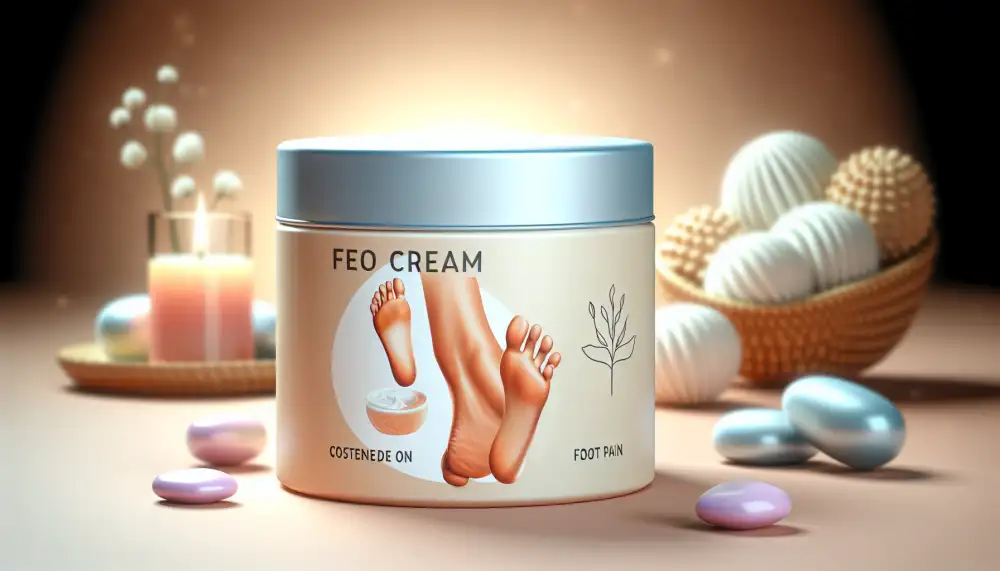Soothe Your Sole: The Best Feet Creams for Pain Relief

Common Causes of Foot Pain
Foot pain is incredibly common and can really cramp your style. Whether it's a dull ache or a sharp stab, figuring out the root of the problem is the first step to finding relief. Let's dive into some usual suspects behind that foot pain.
One common culprit is plantar fasciitis, an inflammation of the thick tissue running along the bottom of your foot. You'll feel this one most in the heel, especially in the morning. Another frequent offender is a heel spur, a bony growth that pops up on the heel bone. Like plantar fasciitis, it can make those first steps of the day brutal.
Don't forget about those pesky bunions! That bump at the base of your big toe is actually a misaligned joint, and it can cause pain, redness, and swelling. Speaking of toe troubles, ingrown toenails can be a real pain, literally. When the edge of your toenail grows into the surrounding skin, it can lead to discomfort and even infection.
Sometimes, foot pain is a symptom of a bigger issue. Conditions like arthritis, diabetes, and nerve damage can all manifest as foot pain. If your pain is persistent or severe, it's crucial to consult a healthcare professional for proper diagnosis and treatment.
How Foot Cream Helps
Foot cream can be a true lifesaver when your feet are aching and tired. But how exactly does it work its magic? The answer lies in the powerful ingredients packed into these soothing formulas. Moisturizers like shea butter, cocoa butter, and hyaluronic acid hydrate the skin, preventing dryness and cracking that can cause discomfort. For pain relief, many foot creams contain analgesics like menthol, camphor, and lidocaine. These ingredients create a cooling or warming sensation that distracts from pain signals and reduces inflammation. Some creams also target specific foot conditions. For example, creams with tea tree oil or eucalyptus oil have antifungal and antibacterial properties that can help with athlete's foot and foot odor. If you have chronic foot pain caused by conditions like plantar fasciitis or arthritis, look for creams with ingredients like arnica, glucosamine, or chondroitin. These ingredients may help reduce inflammation and support joint health. Remember, while foot cream can provide much-needed relief, it's essential to address the underlying cause of your foot pain. If you experience persistent or severe pain, consult a healthcare professional for proper diagnosis and treatment.
Ingredients to Look For
When choosing a foot cream for pain relief, certain ingredients can make a real difference. Look for creams containing menthol and camphor, known for their cooling and soothing properties. They create a tingling sensation that can temporarily distract from pain signals. Arnica montana, a natural extract, is often praised for its ability to reduce inflammation and bruising, making it helpful for pain related to injuries or overuse.

| Feature | Product A (Example Brand) | Product B (Example Brand) |
|---|---|---|
| Pain Relief Ingredients | Menthol, Lidocaine 2% | Capsaicin, Arnica |
| Type of Pain Targeted | Nerve pain, Burning | Inflammation, Muscle soreness |
| Application Frequency | Up to 4 times daily | Twice daily |
| Average Price (for 4 oz) | $12.99 | $9.99 |
Capsaicin, the compound that makes chili peppers hot, might seem counterintuitive, but it can actually block pain signals over time. It's especially effective for nerve pain and conditions like arthritis. If your foot pain is accompanied by swelling, look for ingredients like MSM, a natural sulfur compound known for its anti-inflammatory effects.
Hyaluronic acid is another great ingredient to look for, as it attracts and retains moisture, keeping your feet hydrated and potentially reducing dryness-related discomfort. Finally, don't underestimate the power of natural emollients like shea butter, coconut oil, or aloe vera to soothe and moisturize your skin, enhancing the overall effectiveness of the pain-relieving ingredients.
Let's soothe those weary soles and restore the joy of a carefree step.
Elowen Briarwood
Types of Foot Pain
Foot pain is incredibly common, with various causes and symptoms. Understanding the type of pain you're experiencing can help you find the right treatment, including topical creams designed to alleviate discomfort.
One common type is plantar fasciitis, causing a stabbing pain in the heel, particularly in the morning. This pain stems from inflammation of the plantar fascia, a thick band of tissue supporting your arch. Another frequent culprit is a heel spur, a bony growth on the heel bone, leading to pain with every step.
Metatarsalgia affects the ball of your foot, causing pain and inflammation in the joints at the base of your toes. It's often linked to high-impact activities or ill-fitting shoes.
Arthritis, particularly osteoarthritis, commonly affects the feet, leading to joint pain, stiffness, and reduced mobility. Tendinitis, inflammation of the tendons, can cause pain, tenderness, and swelling, often due to overuse or improper footwear.
If you're experiencing persistent foot pain, it's crucial to consult a healthcare professional for an accurate diagnosis and treatment plan. While topical creams can provide temporary relief from pain and inflammation, addressing the underlying cause is essential for long-term relief.

Choosing the Right Cream
Finding the right cream for foot pain can feel overwhelming with so many options available. Start by identifying the cause of your discomfort. Is it due to overuse, an injury, or a medical condition like plantar fasciitis or arthritis?
For muscle soreness and overuse, look for creams containing analgesics like menthol or camphor, which provide a cooling and soothing sensation. These ingredients work by temporarily blocking pain signals. If inflammation is a factor, consider creams with NSAIDs like ibuprofen or diclofenac. These ingredients reduce swelling and pain.
For chronic conditions like plantar fasciitis, you might benefit from creams that combine pain relief with moisturizing agents like hyaluronic acid or shea butter. These ingredients can help soften the plantar fascia, the thick band of tissue on the bottom of your foot, and reduce pain.
If you have sensitive skin, always test a small amount of the cream on an inconspicuous area before applying it to the entire affected area. Look for fragrance-free and hypoallergenic formulas to minimize irritation.
Remember, topical creams offer temporary relief. If your foot pain is severe or persists, consult a healthcare professional for proper diagnosis and treatment.
Application Tips
Before applying, always wash your feet with lukewarm water and a gentle cleanser. Pat them dry with a soft towel. Dispense the recommended amount of cream onto your fingertips. Gently massage the cream into your feet, focusing on areas experiencing pain or discomfort. Use circular motions and light pressure to work the cream into the skin. For optimal absorption, apply the cream to slightly damp skin. Allow the cream to absorb fully before putting on socks or shoes. Avoid applying the cream to broken or irritated skin. If you experience any adverse reactions, discontinue use and consult a healthcare professional. For best results, use the cream consistently as directed on the packaging. Store the cream in a cool, dry place, away from direct sunlight.
When to See a Doctor
While foot creams can be effective for mild to moderate discomfort, there are times when it's essential to seek professional medical advice. If your foot pain is severe, persistent, or accompanied by other symptoms such as swelling, redness, warmth, or open sores, it's crucial to consult a doctor. Additionally, if your foot pain doesn't improve after a week of using an over-the-counter foot cream or if it worsens despite treatment, medical attention is necessary.
Individuals with underlying medical conditions like diabetes, neuropathy, or circulatory problems should consult their doctor before using any new foot cream. These conditions can affect foot health and sensation, and a healthcare professional can recommend appropriate treatment options. Remember, self-treating can sometimes mask underlying conditions, so it's always best to err on the side of caution and seek professional guidance when needed.

Additional Foot Care Tips
While foot cream can work wonders for pain relief, pairing its use with other foot-care practices can maximize its effectiveness and keep your feet feeling their best. Here are some additional tips to pamper your feet:
- Choose supportive footwear. Opt for shoes that provide good arch support and cushioning to minimize stress on your feet.
- Stretch regularly. Simple foot stretches can help improve flexibility, reduce tightness, and prevent pain.
- Maintain a healthy weight. Excess weight puts added pressure on your feet, increasing the risk of discomfort and pain.
- Keep feet clean and dry. Wash your feet daily with mild soap and water, and dry them thoroughly, especially between the toes, to prevent fungal infections.
- Trim toenails properly. Cut toenails straight across and avoid cutting them too short, which can lead to ingrown toenails.
- Elevate your feet. Propping up your feet on a pillow while resting can help reduce swelling and improve circulation.
- Stay hydrated. Drinking plenty of water is essential for overall health, including foot health.
- Listen to your body. If you experience persistent foot pain or discomfort, consult a healthcare professional to rule out any underlying medical conditions.
Remember, taking care of your feet is crucial for your overall well-being. By incorporating these additional tips alongside the use of foot cream for pain, you can enjoy happy, healthy feet for years to come.
Best Foot Creams for Pain
Foot pain can really cramp your style. Whether you're dealing with arch pain, heel pain, or general foot fatigue, a good foot cream can provide much-needed relief. Look for creams with ingredients like menthol, camphor, and lidocaine for a cooling and numbing sensation that can temporarily soothe aches. Arnica montana is a natural ingredient known for its anti-inflammatory properties, which can be helpful for reducing swelling and bruising. If your foot pain is related to inflammation, consider a cream with ingredients like turmeric or ginger. These natural anti-inflammatories can help reduce pain and swelling. For those with sensitive skin, it's crucial to choose a fragrance-free and hypoallergenic foot cream to avoid irritation. Always patch test a new foot cream on a small area of skin before applying it to your entire foot, especially if you have sensitive skin. Remember, while foot creams can provide temporary relief, it's essential to address the underlying cause of your foot pain. If you experience persistent or severe pain, consult a healthcare professional for proper diagnosis and treatment.

Foot pain can significantly impact daily life, affecting mobility and overall well-being. While various factors can contribute to foot discomfort, finding effective relief is crucial. Topical pain relief creams offer a convenient and accessible solution for many individuals seeking to alleviate foot pain.
By incorporating a foot cream specifically designed to address pain into your daily routine, you can potentially experience a significant improvement in your foot comfort and overall quality of life. Remember to consult with a healthcare professional to determine the underlying cause of your foot pain and discuss the suitability of using a topical pain relief cream as part of your treatment plan.
Published: 30. 06. 2024
Category: Food



